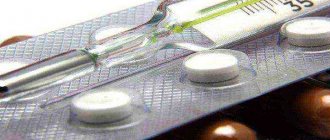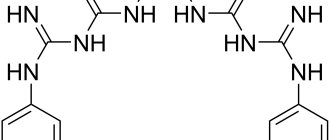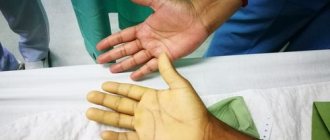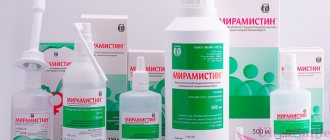Modern pharmaceutical consulting is not only a test of professional knowledge, but also a real test of the character of the leader. Many buyers are confident that they have a good understanding of medications, and from this position they communicate with a pharmacist or pharmacist. At the same time, they can take antibiotics “to prevent ARVI” or retell the most sophisticated advice from popular TV presenters. In such a situation, the chief administrator should, on the one hand, dispense the required over-the-counter drugs, on the other hand, warn the person about the danger of his misconceptions regarding drugs, and on the third, not take on the role of a doctor and not make a diagnosis based on symptoms. Confusion and misunderstanding can arise even over something as simple as a seasonal problem like orolabial herpes. Our “cheat sheets” are intended to help the pharmacist communicate with the client on this topic. With the season of winter infectious exacerbations on the rise, let’s remember once again what most often worries customers with requests for remedies for “colds on the lips.”
Give me some kind of alcohol tincture for colds on the lips - maybe calendula or boric alcohol
Applying alcohol solutions to lesions is a very controversial method. On the one hand, they, of course, dry and have an antiseptic effect. However, not a single tincture, as well as boric or salicylic alcohols, are active against the causative agents of “colds on the lips” - herpes simplex viruses. Moreover: these drugs contain ethyl alcohol in a fairly high concentration - up to 70%. When applied to damaged skin, irritation and even burns may occur, which will only worsen the situation. The pharmacy's assortment today includes products that act directly on herpes viral particles, preventing their reproduction and accelerating recovery. It is these drugs that are considered the “first line” for the treatment of herpes on the lips.
Mechanism of action for herpesvirus
The mechanism of action of chlorhexidine on pathogenic cells lies in the ability of the chemicals in its composition to bind to phosphorus-containing groups on the surface of bacterial particles.
Useful: Genital herpes in men
As a result, the balance of water and salt in the cell changes, and the membrane actively allows fluid to pass through. The latter causes the death of all components inside the structure, and the wall itself ruptures under the pressure of the liquid. This principle of influence of chlorhexidine is observed in a wide range of pathogens.
Which of them are susceptible to the effects of the drug?
- Treponema.
- Chlamydia.
- Ureaplasmosis.
- Gonorrhea.
- Gardenellosis.
- Bacteroides.
- Trichomoniasis.
- Herpes.
All medicines against herpes on the lips are the same, give me something cheaper
Indeed, many drugs intended for the treatment of orolabial herpes contain the same active substance. Most often this antiviral drug is acyclovir, less often - penciclovir. However, there are means that have characteristic differences. For example, one of the creams, along with acyclovir, contains hydrocortisone. This remedy, unlike single drugs, simultaneously prevents the formation of new rash components and shortens the healing time of existing rashes, reducing the severity of the inflammatory reaction and itching [2].
Contraindications after lip augmentation
Lip contouring is considered a safe procedure. After it, you can almost immediately return to your normal lifestyle. The need for care and healing is still present. Although the doctor uses anesthesia, the procedure may be painful. Unpleasant sensations persist in the future. They can follow the patient for up to 3 days. In order not to worsen the condition, it is important to follow a number of recommendations. Thus, the following contraindications apply:
- It is recommended not to eat food for 3 hours. The greatest number of restrictions concerns hot dishes. It is better not to eat them during the day. Otherwise, there is a risk of spoiling the result, as well as injuring the treated area. Therefore, it is recommended to give preference to products at room temperature. Hot and spicy dishes should be excluded from the menu. Eating such food is fraught with inflammation and swelling. It is advisable to cut the food into small pieces. It's better not to open your mouth wide. This increases soreness. On the first day after the procedure, it is highly recommended not to touch the treatment area. This is fraught with infection. It needs some time to heal.
- While your lips are healing, it is better not to use decorative cosmetics. The use of lipsticks, lip pencils, balms, and glosses is prohibited. Their use is fraught with the occurrence of infections.
- Overheating must be avoided. Otherwise, restructuring of hyaluronic acid is possible. It is also better not to use cooling compresses too often. Otherwise, the skin will become excessively dry and microcracks may appear.
- It is recommended to limit physical activity. Also, doctors do not recommend showing facial activity.
- Tanning is banned for one to two weeks. During this period, it is also not recommended to be in the open sun. The above procedures lead to excessive sweating, which increases the risk of infection. Additionally, the development of hyperpigmentation and swelling is possible. All warming procedures are also prohibited. They can lead to the breakdown of hyaluronic acid.
I heard that there are some very effective pills against herpes on the lips. This is true?
Indeed, there are antiviral drugs for the treatment of herpes intended for oral administration. Today, three oral drugs in this group are used - acyclovir, valacyclovir and famciclovir. Penetrating inside a cell infected with the herpes virus, they block DNA synthesis and stop the reproduction of the pathogen. All oral antiviral drugs are available only with a doctor's prescription.
Local forms remain over-the-counter: ointments, gels or creams. For recurrent colds on the lips, it is advisable to use these drugs, since they are practically not absorbed into the bloodstream and do not have a systemic effect.
Drugs against herpes on the lips in tablets can be prescribed in cases where relapses occur very often. This happens, for example, when the immune system is malfunctioning. If you keep having recurrent cold sores, you'd better see a doctor. He will find out why your immune system is not doing its job and may prescribe an oral antiviral medication for herpes.
Forecast and prevention of genital herpes
As a preventative measure to prevent primary infection of HS, it is recommended to use condoms during sex, especially during casual sexual intercourse. But you should know that the use of protective contraception does not reduce the risk of infection through microcracks and other damage in areas of the skin not covered by a condom. If you suspect the penetration of a virus, you can treat the skin with local antiseptic preparations.
GG is characterized by relapses with decreased immunity. To prevent the disease, you should adhere to the following recommendations:
- adhere to a healthy lifestyle;
- take vitamins;
- get enough rest and eat right;
- observe the rules of personal hygiene;
- the area of blisters and ulcers should be dry and clean to avoid infection;
- If symptoms appear, consult a doctor promptly.
People infected with this virus should try to avoid direct contact with others to protect them from infection. Avoid scratching or touching herpes lesions as this may spread the infection to other areas of the skin.
I caught a cold, and lo and behold, my lips were covered. Give me some tea for colds
You are confusing two completely different infections - respiratory and herpes. A cold, or ARVI, develops when the body is infected with respiratory viruses. But a “cold on the lips,” or a relapse of orolabial herpes, appears when the herpes simplex viruses, which live in the body constantly, are activated. Therefore, when itching or rash appears on the lips, traditional cold remedies are not effective: they only act on the symptoms of acute respiratory viral infections or respiratory viruses. In the case of “cold lips,” it is advisable to use antiviral drugs that are active against herpes simplex pathogens.
Diagnosis of genital herpes
Which doctor should I see for genital herpes?
At the Yauza Clinical Hospital, this disease begins with a clinical examination by a specialized specialist (gynecologist or urologist), and is confirmed by laboratory tests. If necessary, consultation with related specialists (immunologist) is carried out.
What tests should be taken for genital herpes?
Laboratory diagnostics solves 2 problems:
- determine the presence of the herpes simplex virus or contact with it: to do this, study the blood, vaginal discharge, urethra, sperm, urine of the patient for the presence of antibodies to the herpes simplex virus, or particles of the virus itself;
- to prove the “involvement” of these rashes with genital herpes: material taken directly from blisters or ulcers is examined.
Also, to select effective therapy, it is necessary to accurately determine the type of pathogen - this question is answered by polymerase chain reaction (PCR).
Make an appointment
Recommend some remedy for cold sore lips for a pregnant woman
Unfortunately, first-line drugs for the treatment of exacerbations of orolabial herpes are indicated for use during pregnancy only if the benefit to the mother outweighs the risk to the fetus and child [2]. Expectant mothers can be encouraged to use a lip balm or cream with a UV filter - it protects the skin of the lips from the negative effects of ultraviolet radiation, which is considered one of the triggers for relapses of herpes. Additionally, I would recommend lip moisturizers to prevent dry skin.
Complications of GG
People with genital herpes face an increased risk of contracting and passing on other STDs. This is because the ulceration that occurs as a result of a herpes infection makes the skin and mucous membranes of the genitals more vulnerable to sexually transmitted infections. Patients with symptomatic HH face a 2-4 times higher risk of acquiring and transmitting HIV infection.
Complications are rare:
- In some cases, the infection can spread to other parts of the body, such as the liver and eyes, even to the lining around the brain, causing meningitis.
- 1% of patients with primary HH develop autonomic dysfunction with urinary retention, erectile dysfunction, constipation, and sensory loss. Sometimes (intermittent) catheterization is necessary over several weeks.
- Mild meningitis is relatively common in primary herpes (13-20%). Herpetic encephalitis occurs less frequently and has a mortality rate of about 70%.
- Neonatal herpes simplex may develop after vaginal delivery and may be accompanied by local infection (skin, eyes, or mouth), disseminated manifestation (visceral organs), or central manifestation (CNS).
Symptoms may be especially severe in people with weakened immune systems due to existing HIV infection or immunodeficiency. An infection that affects the eyes can lead to blindness. This occurs mainly in people with weak immune systems who have had the virus for a long time. With a weak immune system, herpes increases the risk of bacterial infections, which can lead to further complications.
Another possible complication affects pregnant women. During childbirth, women can pass the virus to their newborn. Women at risk for STIs often get tested in the early weeks of pregnancy to prevent complications. A pregnant woman with symptomatic genital herpes is at risk of miscarriage or premature birth.
The infection can be transmitted to the fetus, and the baby may develop neonatal herpes. The risk of complications is especially high if a woman contracts the infection in the last trimester of pregnancy. If she has active genital ulcers near the time of delivery, a cesarean section is usually recommended to avoid exposing the newborn to the virus.
Recommend something effective to get rid of this herpes once and for all
Unfortunately this is not possible. Once entering the body - most often this happens in childhood - herpes simplex viruses never leave it. They penetrate the nerve ganglia of the trigeminal nerve and migrate from them only during relapses, and then return again to the zone of permanent “dislocation”. Activation of the infection occurs against the background of a number of risk factors, or triggers. They can be: fever, stress, fatigue, hormonal changes, respiratory infections, etc. By the way, with age, the frequency of relapses of orolabial herpes decreases.
There is no remedy that would allow you to get rid of herpes infection at once. However, there are drugs that alleviate the condition during the activation of the disease and speed up recovery. These are primarily acyclovir-based products that block the proliferation of herpes viruses. Acyclovir ointments and creams are the drugs of choice for recurrent colds on the lips, having an optimal balance of effectiveness and safety.
Treatment of genital herpes during pregnancy
First of all, it should be noted that there is a group of antiviral drugs that can be used with complete safety for the developing fetus.
Indications for treatment:
- primary infection during pregnancy,
- relapses of the disease and
- prevention of relapses before childbirth.
Taking into account the possibility of an asymptomatic course of the disease during a relapse, it is necessary to conduct periodic examinations of the woman throughout pregnancy and, especially in the last weeks before childbirth.
By contacting the Clinical Hospital on Yauza, you are guaranteed to receive qualified advice from a specialized specialist, an accurate diagnosis of your condition, effective treatment of the identified disease, and prevention of exacerbations of genital herpes and its complications. Take care of your health - make an appointment with a gynecologist or urologist right now!
I always bought ointment with acyclovir for herpes on the lips. Maybe there is something more modern now?
Acyclovir is truly a drug with “experience”: it was synthesized back in 1977 [4]. In those years, it was an innovative drug that offered a unique opportunity to control herpes infection. Today it remains one of the most popular remedies against herpes, although, of course, it has competitors. However, it cannot be said that they have any significant advantages compared to acyclovir.
Thus, the only alternative to local forms of acyclovir, penciclovir, which is also available in the form of an ointment, has a structure and mechanism of action similar to the parent of the group. Research results indicate that 1% penciclovir is as effective for cold sores as 3% acyclovir [5]. However, if acyclovir is applied 5 times a day, then penciclovir should be used a little more often - every 2 hours. Whether it makes sense to change the drug is up to you to decide.
Herpes viral infection: placing emphasis.
– The next, very relevant topic is “Herpesvirus infection”. And I am pleased to give the floor to Andrey Viktorovich Ignatovsky.
Andrey Viktorovich Ignatovsky , Candidate of Medical Sciences:
– Good afternoon, dear colleagues. We continue our conversation about infectious agents. Today, herpesvirus infection remains one of the most pressing problems for doctors of almost all specialties. We very often discuss the negative impact of herpes virus infection in relation to the impact on the reproductive tract - this problem is extremely interesting to obstetricians-gynecologists and urologists. I think that this presentation will show the relevance of this problem for general practitioners and general practitioners.
We usually talk about herpes simplex viruses - the first and second types, and the third type virus - this is the varicella zoster viral infection. And, of course, I would like to start today with the varicella zoster viral infection, because this infection, probably, in the aspect of general medical practice, has an incredible number of interesting and important aspects.
So, type 3 herpes virus. You see that the first encounter with the third type of herpes virus leads to the development of chickenpox. This is a primary infection caused by a type 3 virus. A certain important aspect is that in this case, with a primary infection, the encounter occurred for the first time, the patient does not have antibodies, and the patient is not protected against this infectious agent. Hence, a rather frivolous attitude towards chickenpox can result in fatal cases, which we periodically see in Russia and which are recorded. And, of course, looking at almost all cases, we see that the patient received standard therapy for a mild form, and it was not taken into account that the patient was not protected, and there are etiotropic drugs that were not used in almost all fatal cases prescribed by a doctor. Further, the virus in patients who have had chickenpox remains in the spinal ganglia, and relapses of herpesvirus infection occur in the form of herpes zoster.
For whom is a patient with herpes zoster dangerous? It is dangerous for those patients who have not had chickenpox or have not been vaccinated against it. Today there is vaccination, and we know that we can prevent the occurrence of chickenpox. As for clinical understanding, I would like it to be the same for type 3 virus. We call the primary infection “chickenpox”, the first encounter with the virus – there are no antibodies. But the reactivation of the herpes virus from the dorsal ganglion is already called herpes zoster or herpes zoster, or herpes zoster. This is a slide from one of the conferences where fatal cases were analyzed, and the lecturers presented, among other things, our frivolous attitude towards herpes virus infection caused by the third type virus. Indeed, it seems that it is easier to get over it if there is an outbreak of chickenpox in a children's group - it may be better to take children there who have not been sick, many parents believe. A child exposed to the virus will get sick. I would caution against such reckless tactics. It is better to vaccinate the child in this case, and carefully monitor those children who have chickenpox in order to promptly determine the indications for prescribing systemic etiotropic antiviral drugs. Professor Tatochenko said, in my opinion, a very beautiful and correct phrase: “Infection is always a risk. The doctor’s task is to reduce it to a minimum.” As for chickenpox, as for viral infection, today we can do this in a number of cases and completely avoid severe complications and sometimes deaths.
It must be remembered that etiotropic antiviral drugs that are effective against the first and second type of virus, that is, against the herpes simplex virus, are almost as effective against varicella zoster viral infection. There are differences, I think we will have time to talk about them today, between the effects of acyclovir and penciclovir on the herpes virus of the first, second and third types. But, nevertheless, these drugs are etiotropic in relation to the herpes virus of the first, second and third types.
What danger should expect pregnant women who have chickenpox? The situation is probably not so common, but this leads to a lot of problems. We always discuss this rather large block of issues with obstetricians and gynecologists at our round tables. But it is important for a general practitioner to remember that the risk of chickenpox pneumonia is about 10%.
Returning to the further course of herpes virus infection, it is necessary, of course, to touch upon the issue of herpes zoster. The traditional idea, which many remember from their student days, is that herpes zoster appears in the area of the chest dermatomes, thoracic segments. Of course, yes, but we must remember that almost the entire human body is divided into dermatomes, and we can see the reactivation of a herpes virus infection in the form of herpes zoster in the area of any dermatome.
Here are the traditional clinical manifestations - this is a chest dermatome. Classic manifestations are erythema, edema and grouped microvesicles, blistering rash. But we must remember that if we see lesions in the area of several dermatomes, then, of course, we are talking about the fact that the herpes virus infection is acquiring, or in this case the patient has, a severe course. Dermatomes can be in different localizations, in particular, genital localization can be, these can be manifestations in the sacral area, and here it is necessary to differentiate these manifestations with the zosterophoric course of herpesvirus infection, which can be caused by the herpes simplex virus, but of the second type.
If we are talking about severe, atypical forms, then, of course, we must remember that the third type of virus also has such forms. And here we see the patient’s blisters filled with hemorrhagic contents. This is a hemorrhagic form. There may be typical rashes, but in the breast area. If the patient is not examined completely and does not see this linearity of the rash, then one might think that she has some manifestations on the mammary gland. However, a complete examination of the patient gives an idea and allows for a correct and timely diagnosis.
I would point out that previously the occurrence of herpes zoster in elderly patients was considered traditional. However (and we even wrote an article at our department, observing patients at the Ott Institute of Obstetrics and Gynecology), the patient population has just become younger. We also saw young women, just in the period of pregnancy, in the period of feeding.
We must not forget about special localizations, which are extremely dangerous, primarily due to life-threatening conditions. This is ophthalmoherpes. Ophthalmoherpes is dangerous because the path of development of this inflammatory process affects both the blood vessels and the membranes of the brain. And here the risk of complications is enormously higher. Starting from acute retinal necrosis and ending with stroke. That is why, having met such a patient, a doctor of almost any specialty should not redirect him, playing the role of some kind of “switchman,” but take over the initial stage of patient management, and then attract specialists of the required profile - ophthalmologists, neurologists. But an etiotropic antiviral drug should be prescribed as soon as the patient comes to your appointment. You can consider this an emergency.
The initial manifestations are very interesting. It is always erythema, swelling. There may be no microvesicles, but the fundamentally important point is that (we can go back to the previous slide and look at this slide) clearly half of the face is affected, as if a lesion was drawn along a ruler. But the apex of the nose is always involved if it is affected in the patient. And here we clearly see a unilateral lesion, which makes it easy to make a diagnosis. Neither the allergic process will proceed like this, clearly delineated, nor any other.
It must be remembered that in 10% of patients with normal immunity with herpes zoster, hematogenous spread of the infection with the development of a disseminated form is possible, which should also alert the doctor and make him especially attentive to such patients. We must remember that clinical manifestations are not only rashes, but also pain. It usually accompanies this process and is present in different forms. We will also talk to you about pain options today.
Postherpetic neuralgia is considered one of the most dangerous complications among all the main groups; we see that there are many of them: skin, visceral, neurological, and ocular complications. But postherpetic neuralgia is most difficult to treat with medication. Sometimes, even with correct and timely prescribed therapy, it is impossible to avoid such a complication.
What is postherpetic neuralgia, and who is at higher risk? These are elderly and older patients. The area of the rash matters: the maximum risk is the area of the trigeminal nerve and brachial plexus. Other areas have a moderate or lesser risk, but this does not exclude the occurrence of such pain syndrome. Of course, pain in the prodrome, preceding the rash, and a pronounced rash.
We must remember that the older the patient is, the higher the risk of developing postherpetic neuralgia. What do we mean by postherpetic neuralgia? Perhaps, this Dworkin classification is the most acceptable, and it most correctly shows us that we can consider postherpetic neuralgia to be pain that lasts four months or longer. Everything up to four months is divided into either acute herpetic neuralgia or subacute herpetic neuralgia. A fundamentally important point in this classification is the therapeutic approaches. They are different. At the initial stage of the disease, along with inflammatory pain caused by the influence of the virus, neuropathic pain also arises. The fundamental difference is that we can effectively control inflammatory pain with non-steroidal anti-inflammatory drugs and analgesics. But unfortunately, we cannot influence the pain, which is called neuropathic, with anti-inflammatory drugs and analgesics, and over time, just by the fourth month, the significance of inflammatory pain practically decreases, but the significance and role of neuropathic pain increases enormously. That is why for patients who have been ill for a long time, whose pain persists after suffering from herpes for four months or more, the prescription of analgesics is useless; completely different classes of drugs must be prescribed, involving a neurologist for consultation. Without a neurologist, competent treatment of such a patient is impossible.
You see that the types of pain can be completely different - this is both acute and tearing pain. Sometimes it can be allodynia - pain with a light touch. But, nevertheless, all this causes extreme suffering to our patients. How to avoid this pain? How to avoid postherpetic neuralgia? Early appointment – up to 72 hours. Doctors often misunderstand 72 hours. The patient came back after 74 hours, but he has rashes, there is activity of the process - we must still prescribe such therapy. We are talking about ideal conditions - the sooner such therapy begins, the better results we will get. Of course, the prescription of highly effective antiviral drugs, I am primarily talking about famciclovir, adequate pain relief in the acute stage. Quite good preliminary results have been obtained on the effectiveness of vaccination. What treatment principles exist today for herpes virus infection? Of course, this is etiotropic therapy. It must be remembered that nucleoside analogues are the drugs of choice today for the treatment of all forms of herpesvirus infection. Immunomodulatory therapy is pathogenetic therapy. We can do without her. It is not included in any protocol - international or domestic. Symptomatic therapy, of course, has a certain value.
And, of course, you need to remember that etiotropic drugs are acyclovir, its valino- and fervalocyclovir and famciclovir. (00:12:30) Symptomatic therapy will most likely be required for a patient with herpes zoster. These are analgesics, non-steroidal anti-inflammatory drugs and, at the stage of pain control, physiotherapy, but not ultraviolet radiation. It must be remembered that ultraviolet radiation is an aggressive, damaging factor. Tanning is a protective function of the skin.
When choosing a drug, you must remember that the most sensitive to acyclovir - the herpes simplex virus of the first and second types, varicella zoster - is more than 20 times, and cytomegalovirus is 470 times less sensitive to acyclovir than the herpes simplex virus of the first type. If we talk about drugs, then, of course, we need to remember that today both acyclovir drugs (acyclovir and valacyclovir, and famciclovir) differ in bioavailability. The bioavailability of drugs is different, due to their pharmacokinetic characteristics and, above all, accumulation in certain structures. And it is important for us, when speaking and discussing herpes virus infection caused by herpes simplex virus and herpes virus type 3, accumulation in Schwann cells, because the spread of the virus from the spinal ganglion occurs perineurally, periaxonally and, precisely, along Schwann cells. The concentration of penciclovir - the active substance famciclovir - is many times higher than the concentration of acyclovir.
And one more important point - we say that abnormal nucleosides become active under the influence of the enzymes of the herpes virus itself and accumulate only selectively in infected cells. We must remember that all acyclovir drugs (this applies to acyclovir, valacyclovir) are intracellular for less than an hour or about an hour. If we are talking about famciclovir, then you see, based on the table, which, in fact, is based on data from numerous studies, that the varicella zoster virus allows the drug to remain in the infected cell from 7 to 11 hours.
The route of elimination is the kidneys. We must now remember this very important aspect, because at the end of my presentation I will show questions, and we will touch upon the issues of medicinal safety of the use of these drugs. If we talk about comparative analysis and dosages of drugs, then, undoubtedly, such studies have also been conducted. And you see in this diagram the comparative dosages of famciclovir at a dose of 250 mg three times a day, 500 mg three times a day. And a comparison with acyclovir - the traditionally known dose of 800 mg five times a day.
We see, of course, that acyclovir is lagging behind. Its pharmacokinetic and pharmacodynamic properties differ from famciclovir. And, of course, the powerful effect with a more modern form of famciclovir provides better therapeutic indications, which is why today it is considered the number one drug for the treatment of herpes virus infection, caused, in particular, by the herpes virus type 3.
If you and I are discussing indications, then, of course, in this case herpes zoster is important to us. We have already discussed accumulation in Schwann cells. And the dosages will vary: in patients with normal immunity, the dosage is 250 mg three times a day, or 500 mg twice a day. The only difference, when the dosage will need to be doubled or increased, is ophthalmoherpes. Essentially, we have to say that in immunocompromised patients the dosages will always be doubled. And patients with ophthalmoherpes, even with normal immunity, still require high dosages. This is a dosage of 500 mg three times a day. If we are talking about herpes zoster in patients with reduced immunity, then famciclovir is also prescribed in double dosage, and the duration of therapy is 10 days.
Pay attention to this slide - this is a patient with ophthalmograpes. Here the dosage should also be 500 mg three times a day. Undoubtedly, it is necessary to involve a neurologist and an ophthalmologist for consultation.
Speaking about immunocompromised patients, with insufficient immunity, we must, of course, not forget about patients with the immunodeficiency virus. The thing to remember here is that famciclovir is the only drug approved by the FDA to treat both herpes zoster and genital herpes in HIV-positive patients.
If we touch on the issue of treating postherpetic neuralgia, it should be noted that drugs such as gabapentin and pregabalin will be effective in influencing neuropathic pain. And, we discussed this aspect, it is imperative to involve a neurologist. It is he who should prescribe such drugs. They may be given concomitantly with famciclovir or another abnormal nucleoside, or may be given soon after. That is, in fact, there is no need to wait for the development of postherpetic neuralgia and such a diagnosis. Recent studies have shown that the earlier we prescribe such drugs, the better the effectiveness in treating this condition. You see that there are drugs for second-line treatment, and, of course, there are certain approaches. First of all, we focus on the visual analog pain scale. And, understanding that we received or did not receive the effect of the therapy, we can adjust this therapy. This means that you need to understand that therapy is not straightforward. It is difficult for the patient, its tolerance is not always easy and simple. This requires special attention, and, I repeat once again, it is better to prevent it - by early adequate prescription of an etiotropic antiviral drug.
In the second block I would like to discuss herpes virus infection caused by herpes simplex virus types 1 and 2. Traditionally, we have divided: conventionally, we believed that the first type of virus affects the upper part of the body, localizing in the area of the face and lips. And the second herpes virus was considered genital. However, laboratory diagnostics are improving, and today we know that these viruses no longer have the clear anatomical connection that we previously distinguished.
We must, of course, remember that we distinguish between primary herpes and recurrent forms of herpes virus infection. Clinical features: acute onset of primary infection, symptoms of intoxication, enlargement of regional lymph nodes - these are, in fact, the main clinical signs. And the laboratory results will be an increase in the level of antibodies. More often we encounter primary infection in children. And this form is herpetic gingivostomatitis, herpetic manifestations in the lip area - labial herpes. If we are talking about genital localization, about the period when a person did not encounter this virus in childhood, but, having already begun sexual activity, received the virus - in this case, of course, primary genital herpes develops. Other manifestations are also possible.
If we talk to you about the symptoms of relapse, they are well known. Prodromal phenomena in the form of pain, itching, burning, discomfort in the rash area, and later clinical manifestations. They may not always be in the form of erythema and edema; both typical and atypical forms may appear. In the case of an atypical course, we will not see bubbles, as we discussed, either these bubbles will be filled with hemorrhagic contents, or they may even be blisters.
Of course, it is necessary to distinguish between degrees of severity - mild, moderate and severe. It is this aspect that will determine the doctor’s approach, planned activities and, of course, the aspect of patient consultation. If we talk about clinical manifestations, they are well known. However, it is necessary to clarify whether this is a primary herpesvirus infection or a relapse. Clinical manifestations may be somewhat similar; only laboratory tests will allow us to distinguish between primary infection and relapse. In the event of a complication, as you see on this slide, a discussion will be required regarding the use of topical or perhaps even systemic antibacterial drugs.
In the case of herpetic glossitis - a lesion of the oral mucosa - topical drugs, of course, cannot be used, and only systemic etiotropic antiviral drugs will necessarily be discussed here. Well, in this case, one should, of course, not forget that there is a risk of developing ophthalmoherpes, developing herpetic keratitis, and here an extremely important issue will, again, be a discussion not only of the use of eye drops that have an antiviral effect, but also necessarily in the prescription of systemic etiotropic antiviral drugs.
Speaking about treatment strategies for herpesvirus infection, you need to remember that there is treatment, it differs in dosage, primary infection of relapse and two options for suppressive therapy - episodic suppressive therapy in anticipation of medical manipulations and long-term suppressive therapy to prevent relapses and prevent transmission to a partner. What is important? It is important that the use of external forms today should be limited. European guidelines for the management of patients with genital herpes in 2010, citing previously published work, showed that the use of topical drugs contributes to the development of resistance to this drug. Therefore, it is necessary to limit the use of topical forms. If we are talking about the use of the drug for primary infection, here I will say what differs today is the dosage. For famciclovir they remained 250 mg three times a day, but for valacyclovir the CDC since 2010, and the World Health Organization increased the dosage since 2003. This dosage for the treatment of primary infection is 1000 mg twice daily. If we are talking about the use of valacyclovir and acyclovir, we must remember that the active substance remains the same acyclovir. By combining with the amino acid valine, a complex is obtained, which, yes, is well absorbed, but the active ingredient remains acyclovir. The dosages used to treat recurrent infections are presented on the slide. Famciclovir has the smallest dosage - it is 125 mg twice a day, for valacyclovir this dosage is 500 mg twice a day, for acyclovir this dosage can vary, ranging from 200 mg to 400 mg per single dose, and the number of such doses is from three until five.
The new dosage for famciclovir, registered in the instructions, is short courses. In fact, the whole world is fighting for such short courses. The use of the drug in case of frequent relapses contributes to the rapid relief of symptoms, while the level of antibodies increases, which further contributes to an easier course of the herpes virus infection. And this three-day treatment regimen is quite convenient for our patients. It is necessary, of course, to remember the difference in drugs, because the development of acyclovir-resistant strains today will probably slowly take one of the leading leading positions.
How do the drugs work? So, the virus has entered the cell, and then the assembly of viral DNA begins under the influence of two viral enzymes - viral thymidine kinase and viral polymerase. And the drugs that enter the cell - acyclovir and penciclovir - are similar to guanosine, one of the components of viral DNA. Next, the thymidine kinase of the virus makes acyclovir active, and this acyclovir molecule remains, relatively speaking, alone. If we are talking about penciclovir, then the situation is as follows: the thymidine kinase of the virus also activates penciclovir, but the thymidine kinase of the virus has a hundred times greater aggregation of penciclovir, and the number of penciclovir molecules is many times higher intracellularly. And then the viral polymerase mistakenly integrates penciclovir into the terminal sections of DNA, since they are abnormal, there is no complementary tail and, accordingly, the assembly of viral DNA stops. Thus, the drugs only work in those cells where the virus is present. Where there is no virus, where the virus does not replicate, the drug will not work. This is extremely important. Well, the concentration of penciclovir on the left graphs is high and stable and does not decrease over time. But acyclovir triphosphate, unfortunately, leaves the plasma very quickly, and its therapeutic concentrations quickly fall.
Speaking about labial herpes, concluding our conversation, it must be said that there is a short single-dose regimen - three tablets of 500 mg, a convenient pulse regimen, and we must, of course, not miss this opportunity, because labial herpes is often a start for some patients development of complications from the nervous system. This must be remembered.
And in conclusion, I would like to cite the work that was published in 2008. It struck me with its abstract - we don’t often pay attention to side effects and drug safety issues, but the abstract is quite interesting. The instructions for acyclovir preparations indicate that it is necessary to ensure adequate hydration of the patient even in tablet forms. But, please note, this article discusses issues when patients were given intravenous acyclovir, high dosages were required due to the severity of this process, and complications in the form of acute renal failure were obtained. What causes such complications? First of all, the molecular structure of acyclovir. It has a crystalline structure, and these crystals can damage the tubular apparatus of the kidney and, in fact, lead to the development of acute renal failure. These patients were subsequently switched to famciclovir and recovered successfully. Just the same, when using acyclovir preparations, you need to remember that both when administered intravenously and when prescribing tablet forms, it is necessary to provide the patient with good hydration.
Thank you for attention.








